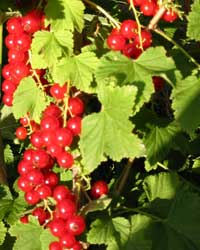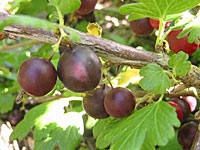Plant of the Week- Currants & Gooseberries
Currants and Gooseberries are all members of the genus Ribes. This large genus includes all the fruiting black, red, and white currants, gooseberries, and hybrids including Jostaberry, as well as many flowering ornamental shrubs (including our native Red Flowering Currant, Ribes sanguineum).
For many years, the planting of Ribes, both fruiting and flowering, was restricted in North America as the plants can be the alternative host for white pine blister rust. This rust is a serious disease of all five-needled pines, and is a threat to the main timber species in the Northeast and New England regions. It was found, however, that most native species of Ribes can also act as alternate hosts, so restrictions have been lifted in most states.
Planting currants and gooseberries for their fruit is not nearly as common as planting blueberries and other berry plants. But both are extremely easy plants in the garden, tolerating some shade and a wide range of soil types.

Rovada Red Currant
The fruit of currants are borne on long stems (strigs). They have a small, soft seed inside. The fruit of red and white currants is sweet-tart in flavor, good fresh or in sauces and jellies. Black currants have a stronger flavor, and is often used for making liqueurs, Gooseberries are larger in size and are borne on single stems along the branches. They also are sweet-tart in flavor, excellent for cooking and processing. Both currants and gooseberries are high in natural pectins, and can be made into jams or jellies without additional pectin added.

Black Velvet Gooseberry
When planting currants and gooseberries, try to choose mildew resistant varieties. This is the most common disease, and is more severe on gooseberries. Many of the newer varieties out there are resistant to both powdery mildew and to blister rust. The plants have only a few pest issues as well; look for aphids on the new growth in late spring or early summer.
There are also two sawflies that can be a problem:
- The imported European currant worm is relatively common, and affects gooseberries and red and white currants. This sawfly larvae hatches just as the currants flower, and the small worms can quickly defoliate the shrub. Hand picking is one good option, and there are a couple of organic insecticides that are also effective.
- The gooseberry maggot is a more serious problem, as this fly lays her eggs on the newly formed fruit, just after bloom. The larvae hatches and burrows into the fruit, effectively ruining the berry. A spray just after bloom can help. Also, laying groundcloth down can prevent the larvae leaving fallen fruit from getting into the soil to pupate.
Currants and gooseberries are rarely grown commercially in the Pacific Northwest, but are starting to gain attention as restaurant and processing demands grow. Look for them from small farmers at local farmers markets, starting in early July. You may find a new fruit to love!

